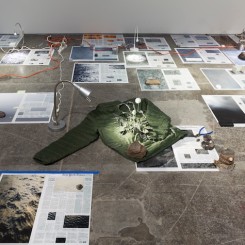—Sarah Sze at Victoria Miro
Sarah Sze solo show Victoria Miro Gallery I (16 Wharf Road, London N1 7RW), Jan 30–Mar 28, 2015
After representing the American Pavilion for the 2013 Venice Biennale, Sarah Sze has now moved on to occupy both Victoria Miro’s spaces in London, in what is in fact Sze’s third exhibition with the gallery. However some might remember that as much as 15 years ago Sze made an installations at London’s ICA, using her then characteristic materials of choice—Q-tips (cotton swabs), tooth picks—and other man-made multiples from discount “pound” shops in an intricate Seussian constellation. By contrast these works now on display appear, at least on the surface, to be more restrained and the materials have been refined in nature’s favor, a transition that roughly began with her New York Asia Society installation in 2011. Yet there is also artifice in the sparser elements of clay, threads, metal, paper and stone . . . or in this case faux rocks made from textiles bound over wire armatures.
The Wharf Road location is used to display pieces Sze began working on in September 2013, right after the Biennale, during a residency at the Fabric Workshop and Museum, Philadelphia, where she experimented with printing on the construction fabric Tyvek1 —thus what was seen in situ in Philadelphia Sze has now reconfigured in London.
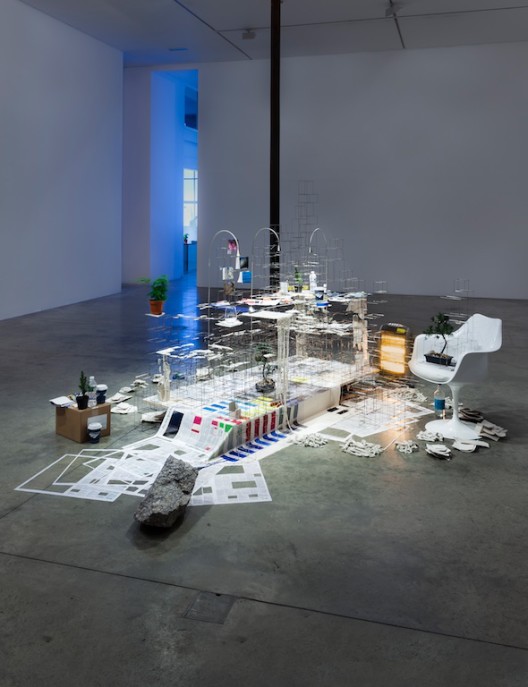
Detail of “Still Life with Desk”, 2013-2015 (Courtesy the Artist and Victoria Miro, London ©Sarah Sze)
萨拉·施,《有桌子的静物》,2013-2015(版权归艺术家及维多利亚·米罗画廊所有)
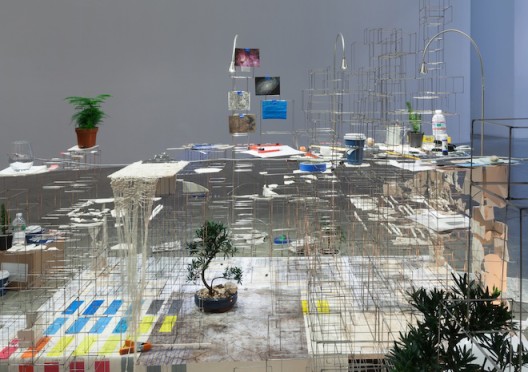
Detail of “Still Life with Desk”, 2013-2015 (Courtesy the Artist and Victoria Miro, London ©Sarah Sze)
萨拉·施,《有桌子的静物》,2013-2015(版权归艺术家及维多利亚·米罗画廊所有)
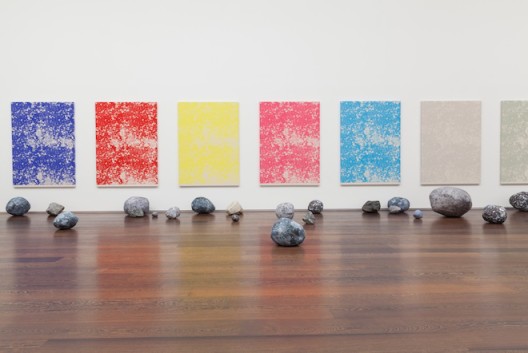
Sarah Sze Installation view, “Stone Series” 2013-2015 (Courtesy the Artist and Victoria Miro, London © Sarah Sze)
萨拉·施,《石头系列》,展览现场,2013-2015(版权归艺术家及维多利亚·米罗画廊所有)
The entrance-level piece, “Still Life with Desk”, was originally site-specific, as it is modeled on the actual Philadelphia reception desk; however, in general terms it is the back office made center stage. Sze likes to say “each piece should feel like a studio visit”, hence the discarded coffee cups (imported from the American state-owned passenger-rail company, Amtrak) and ordered chaos of stationery. The work conjures up a kind of suspended moment, as if the artist has just stepped out of the room. The desk is made of familiar transparent wire cubes, but in line with her trademark disruption of scale, they could also be architectural models for office blocks and the overhanging lights could take on a second identity as street lamps. The colorful elements are minimal—a couple of cacti, some blue masking tape—and it all sits on color samples that stem from the work upstairs. Elsewhere we see dripping wedges of clay, some macramé on a clipboard and random photographs, all governed by the principles of “feng shui”—another recent addition to her work. The work is not a facsimile replica of the Philadelphia piece (about 20% of the objects were found locally), but she is happy to let individual works evolve. This is firmly within the tradition of her 3D drawings, that “draw” one in with the “residue of emotion” and emphasis on negative space.
Upstairs a game of rock-paper-scissors is at play with her “Calendar Series” which comprises three months’ worth of bowdlerized New York Times front pages, which lie on the floor, their photos of current news events cut out and replaced by photographs of natural elements: stones, fire, earth and sky, all potentially transient, but on a monumental scale. Adhering to her previous pattern of categorization, she has made little piles of textured sand and objets on the photographs, matching the colors and contrasting textures, with small rocks holding them in place. The newspaper series starts in September 2013, and was an effort to capture the specific passing of time of her Philadelphia residency. Their positioning on the floor underlines how quickly newspapers are disposed of and reused, especially, for instance, by painters when used to prevent drippage. The headlines are so specific, yet the replacement photographs convey no information about time or location. The installations individualize each newspaper, while the black and white schema frames the un-framable.
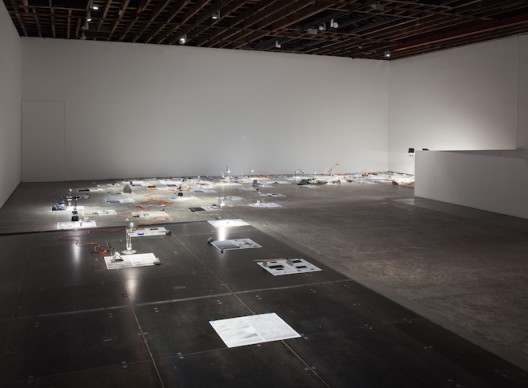
Installation view, Calendar Series, 2013-2015 (Courtesy the Artist and Victoria Miro, London ©Sarah Sze)
《日历系列》,展览现场,2013-2015(版权归艺术家及维多利亚·米罗画廊所有)
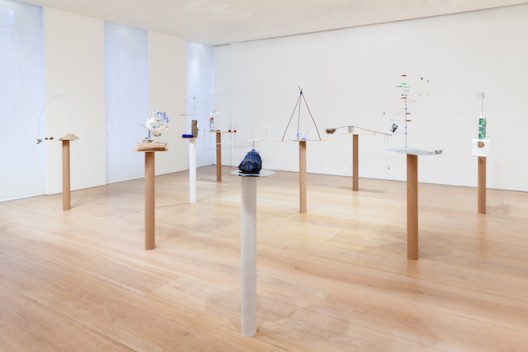
Installation view, Model Series, 2015 (Courtesy the Artist and Victoria Miro, London ©Sarah Sze)
《模型系列》,展览现场,2015(版权归艺术家及维多利亚·米罗画廊所有)
Finally one reaches the main rock installation on the upper level, which is in itself a kind of constellation. On the wall, the “Stones Series” is a sequence of thirteen abstract canvases of lichen and rock surfaces, some in the magenta, cyan and yellow of process color printing, others in darker monochrome. Each piece relates to the various groupings of “Four Rocks in a Landscape”, many of which are actually sculptures of rocks made of photographs printed on fabric and stretched over wire. Sze has been using them in recent installations, and they particularly featured in Venice, where they referred to John Ruskin’s three-volume architectural and cultural history “The Stones of Venice” (1851-1853), which was also a prim warning to his own England about the risk of cultural decline arising from overweening secularism eclipsing pious Christian observance. However Sze herself has noted her conscious reception of traditional Chinese scholar’s rocks (供石; gōngshí) and the careful placing reflects this. In this room her focus is on how the properties of a material used for both sculpture and architecture can be exposed and inverted. These are not the found objects they seem. If the Venice show was about “orientation and disorientation” (many of the rocks there had concentric circles of colorful thread that was quite topographical), then in phenomenological terms these have now become literal stepping-stones in her ‘life-world’ and practice.
The Mayfair gallery features a series of smaller sculptures that are also essentially phenomenological models for abstract concepts that can be very transient and fragile as ideas. As in the desk piece, these excite by creating a suspense of gravity versus line. They are both intricate and sparse, and decisively subjective and delicate in concept and form. Each plays with shifting scales and the idea of “ebb and flow,” as the “crescendos and pauses” of her large-scale work can never quite be encapsulated in a gallery environment.
There are also silkscreen prints from the Midnight Series that further explore the contrast between daily newspapers and an abstract image like the night sky, which she created over New Year’s Day 2014 by gathering different world newspapers and inserting pictures of the midnight sky into their front pages. As there are twelve over twelve time zones, together they act as a world clock, tracing the rotation of the earth on the first day of the New Year.
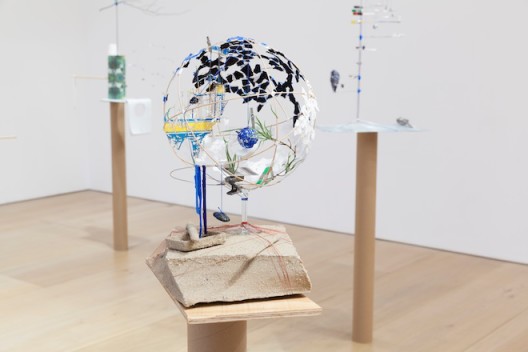
Installation view, Model Series, 2015 (Courtesy the Artist and Victoria Miro, London ©Sarah Sze)
《模型系列》,展览现场,2015(版权归艺术家及维多利亚·米罗画廊所有)
Notes 1. Tyvek is a high-density polymer fabric made by the DuPont company. Sarah Sze is a full professor of Fine Art at Columbia, and is now working on an installation that will feature her drawings on large-scale ceramics at the 96th St subway station in New York. She was born in Boston, and is the granddaughter of Szeming Sze, an important Chinese diplomat who was educated in England between the wars and one of those responsible for establishing the World Health Organisation. Harriet Landseer is based in Prague, where she arranges and accompanies specialized art tours to the Czech Republic and Central Europe for numerous UK and U.S. museums. Her many other interests include contemporary art, coffeehouse culture, children’s book illustration and in November 2015 she is arranging a conference on Chinoiserie in Central Europe.

